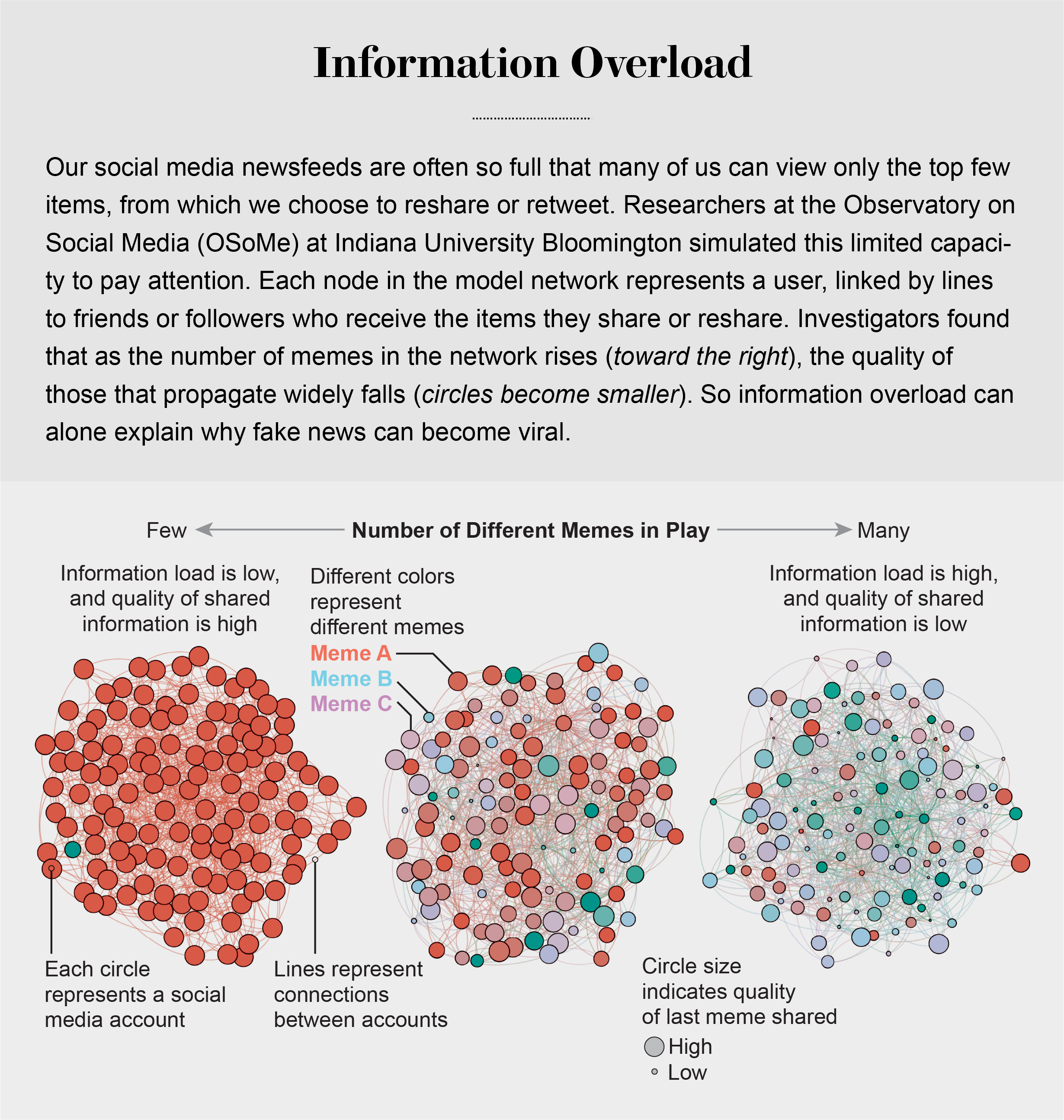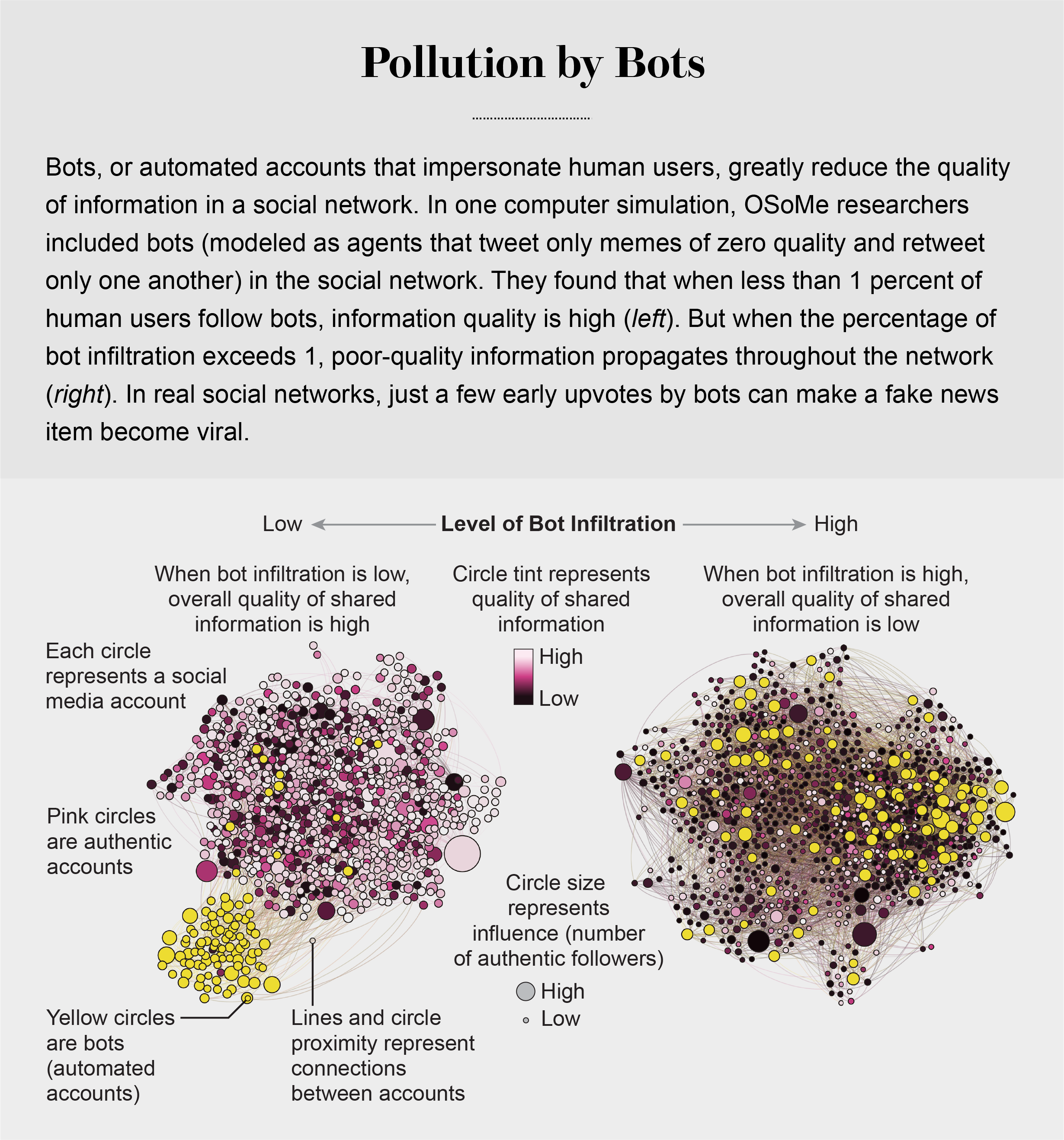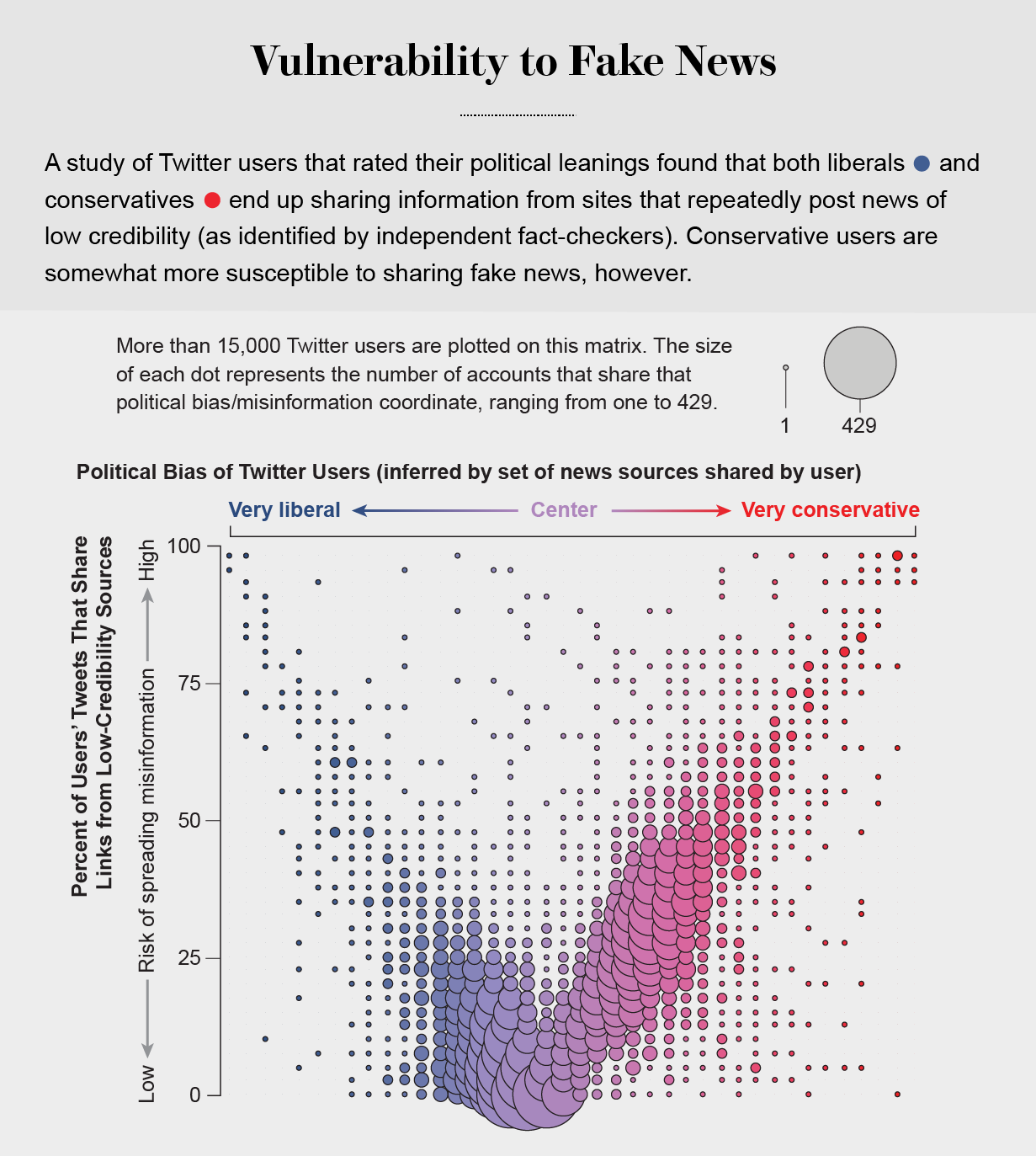Information Overload Helps Fake News Spread, and Social Media Knows It
Understanding how algorithm manipulators exploit our cognitive vulnerabilities empowers us to fight back
https://www.scientificamerican.com/article/information-overload-helps-fake-news-spread-and-social-media-knows-it/
a minefield of cognitive biases.
People who behaved in accordance with them—for example, by staying away from the overgrown pond bank where someone said there was a viper—were more likely to survive than those who did not.
Compounding the problem is the proliferation of online information. Viewing and producing blogs, videos, tweets and other units of information called memes has become so cheap and easy that the information marketplace is inundated. My note: folksonomy in its worst.
At the University of Warwick in England and at Indiana University Bloomington’s Observatory on Social Media (OSoMe, pronounced “awesome”), our teams are using cognitive experiments, simulations, data mining and artificial intelligence to comprehend the cognitive vulnerabilities of social media users.
developing analytical and machine-learning aids to fight social media manipulation.
As Nobel Prize–winning economist and psychologist Herbert A. Simon noted, “What information consumes is rather obvious: it consumes the attention of its recipients.”
attention economy

Our models revealed that even when we want to see and share high-quality information, our inability to view everything in our news feeds inevitably leads us to share things that are partly or completely untrue.
Frederic Bartlett
Cognitive biases greatly worsen the problem.
We now know that our minds do this all the time: they adjust our understanding of new information so that it fits in with what we already know. One consequence of this so-called confirmation bias is that people often seek out, recall and understand information that best confirms what they already believe.
This tendency is extremely difficult to correct.
Making matters worse, search engines and social media platforms provide personalized recommendations based on the vast amounts of data they have about users’ past preferences.
pollution by bots

Social Herding
social groups create a pressure toward conformity so powerful that it can overcome individual preferences, and by amplifying random early differences, it can cause segregated groups to diverge to extremes.
Social media follows a similar dynamic. We confuse popularity with quality and end up copying the behavior we observe.
information is transmitted via “complex contagion”: when we are repeatedly exposed to an idea, typically from many sources, we are more likely to adopt and reshare it.

In addition to showing us items that conform with our views, social media platforms such as Facebook, Twitter, YouTube and Instagram place popular content at the top of our screens and show us how many people have liked and shared something. Few of us realize that these cues do not provide independent assessments of quality.
programmers who design the algorithms for ranking memes on social media assume that the “wisdom of crowds” will quickly identify high-quality items; they use popularity as a proxy for quality. My note: again, ill-conceived folksonomy.
Echo Chambers
the political echo chambers on Twitter are so extreme that individual users’ political leanings can be predicted with high accuracy: you have the same opinions as the majority of your connections. This chambered structure efficiently spreads information within a community while insulating that community from other groups.
socially shared information not only bolsters our biases but also becomes more resilient to correction.
machine-learning algorithms to detect social bots. One of these, Botometer, is a public tool that extracts 1,200 features from a given Twitter account to characterize its profile, friends, social network structure, temporal activity patterns, language and other features. The program compares these characteristics with those of tens of thousands of previously identified bots to give the Twitter account a score for its likely use of automation.
Some manipulators play both sides of a divide through separate fake news sites and bots, driving political polarization or monetization by ads.
recently uncovered a network of inauthentic accounts on Twitter that were all coordinated by the same entity. Some pretended to be pro-Trump supporters of the Make America Great Again campaign, whereas others posed as Trump “resisters”; all asked for political donations.
a mobile app called Fakey that helps users learn how to spot misinformation. The game simulates a social media news feed, showing actual articles from low- and high-credibility sources. Users must decide what they can or should not share and what to fact-check. Analysis of data from Fakey confirms the prevalence of online social herding: users are more likely to share low-credibility articles when they believe that many other people have shared them.
Hoaxy, shows how any extant meme spreads through Twitter. In this visualization, nodes represent actual Twitter accounts, and links depict how retweets, quotes, mentions and replies propagate the meme from account to account.
Free communication is not free. By decreasing the cost of information, we have decreased its value and invited its adulteration.
It’s 2020: Why Is The Internet Still Treated Like A Luxury, Not A Utility? from r/technology
It’s 2020: Why Is The Internet Still Treated Like A Luxury, Not A Utility?
https://gothamist.com/news/its-2020-why-is-the-internet-still-treated-like-a-luxury-not-a-utility
The city Board of Estimate first decided back in 1965 to slice up the city into cable-TV franchise fiefdoms, a setup that has survived largely intact in the internet era. Today, Altice (aka Optimum) has exclusive cable rights to the Bronx and southeast Brooklyn, while Charter (aka Spectrum, formerly Time Warner) has the rest of the city; Verizon FiOS is also available in a slowly expanding patchwork of areas overlying those two. As a result, most city residents have at most one other option if they’re unhappy with their current service, and many have none at all.
Americans weren’t always beholden to their local cable and phone companies for internet access, notes Christopher Mitchell, director of the Community Broadband Networks Initiative for the D.C.-based Institute for Local Self-Reliance. In the 1990s, thousands of internet service providers across the country offered dialup connections for relatively low prices, connecting via the copper wires of the phone system. The Telecommunications Act of 1996, he says, was initially designed to build on this by enabling multiple providers to use the new, faster networks that were then starting to be rolled out using higher-capacity coaxial and fiber-optic cable. It didn’t quite pan out.
“Both the Clinton and the Bush administrations dismantled that, under pressure from the big cable and telephone companies,” says Mitchell. “Most of those internet access providers went out of business, because they didn’t have access to the networks. If you have a policy that requires a company to pay $1,500 per home to get a subscriber, and it takes three to four years to earn that money back, you will not have much competition.”
The result has been a network of broadband services that are unaffordable or unavailable for a persistently high number of local households.
Torres noted that the city has spent nearly $300 million on renting otherwise-vacant hotels to house homeless New Yorkers during the pandemic, but hasn’t asked for the hotels to allow residents access to their broadband routers.
++++++++++++++
more on netneutrality in this IMS blog
https://blog.stcloudstate.edu/ims?s=netneutrality
https://www.iste.org/explore/5-competencies-digital-citizenship
The five competencies of digital citizenship
Inclusive:
I am open to hearing and respectfully recognizing multiple viewpoints, and I engage with others online with respect and empathy.
Informed:
I evaluate the accuracy, perspective, and validity of digital media and social posts.
Engaged:
I use technology and digital channels for civic engagement, to solve problems and be a force for good in both physical and virtual communities.
Balanced:
I make informed decisions about how to prioritize my time and activities online and off.
Alert:
I am aware of my online actions, and know how to be safe and create safe spaces for others online.
++++++++++++
more on digital literacy in this IMS blog
https://blog.stcloudstate.edu/ims?s=digital+citizenship
What the Stockdale Paradox Tells Us About Crisis Leadership
https://hbswk.hbs.edu/item/what-the-stockdale-paradox-tells-us-about-crisis-leadership
“I lived on a day-to-day basis. … [M]ost guys thought it was really better for everybody to be an optimist. I wasn’t naturally that way; I knew too much about the politics of Asia when I got shot down. I think there was a lot of damage done by optimists; other writers from other wars share that opinion. The problem is, some people believe what professional optimists are passing out and come unglued when their predictions don’t work out.”
The Stockdale Paradox—have faith, but confront reality—can be seen in slightly different forms in many cultures.
Stockdale himself was a follower of the ancient Greek Stoic philosophers, who were noted for their concern with understanding reality correctly and shaping one’s response to it optimally. The maxim of Epictetus, “What, then, is to be done? To make the best of what is in our power, and take the rest as it naturally happens,” has similarities to both Buddhist doctrine and the Alcoholics Anonymous Serenity Prayer. (“God, grant me the serenity to accept the things I cannot change, courage to change the things I can, and wisdom to know the difference”). Therapy techniques such as radical acceptance similarly emphasize the point of letting go of desires and beliefs about what should be and seeing reality as it is.
In the words of Marsha Linehan, the founder of radical acceptance: “Radical acceptance doesn’t mean you don’t try to change things … You can’t change anything if you don’t accept it, because if you don’t accept it, you’ll try to change something else that you think is reality.”
Research by Leach and others indicates that people who survive disasters are able to regain cognitive function quickly after the event, assess their new environment accurately, and take goal-directed action to survive within it. This is the balance that the Stockdale Paradox facilitates: the realism to let go of intrinsic survival mechanisms and the deep-seated faith to learn the new ones.
the pattern of human response to disasters has been shown to be remarkably consistent across cultures, and for disasters of many different causes, effects, and durations, from earthquakes to shipwrecks to kidnapping.
Advice and exercises for leaders
Begin meetings by having each person introduce themselves by their name, job title, mission, and their immediate tasks
This provides practical information to rescuers, but also has the effect of bringing people back to themselves and helping them begin to focus again.
Angela Duckworth’s concept of grit may be useful here. By grit, Duckworth does not mean endurance for its own sake, but rather commitment to a high-level goal, purpose, or mission—and the ability to assess and revise lower-level goals and tactics as necessary.
One question should be regularly asked at meetings: “What is something that doesn’t fit in, that doesn’t make sense?”
Normalize admitting these mistakes and analyzing them. Discuss weak spots, harm reduction, and damage control—people will sometimes fall when traveling uncertain terrain, so how can they fall without injuring themselves?
Create ways for your team to surface both their deep faith and their real fears.
In mental contrasting, a person:
- Visualizes a goal and its rewards, and then
- Visualizes what obstacles—including their own behavior—stand between them and their goal. (It is important to do it in this order.)
In their paper on the Stockdale Paradox, authors C. W. Von Bergen and Martin S. Bressler point to previous studies that show when people focus on only positive thoughts about the future, “they literally trick their minds into thinking they have already succeeded and, so, do not need actual efforts to attain something perceived as already acquired.


